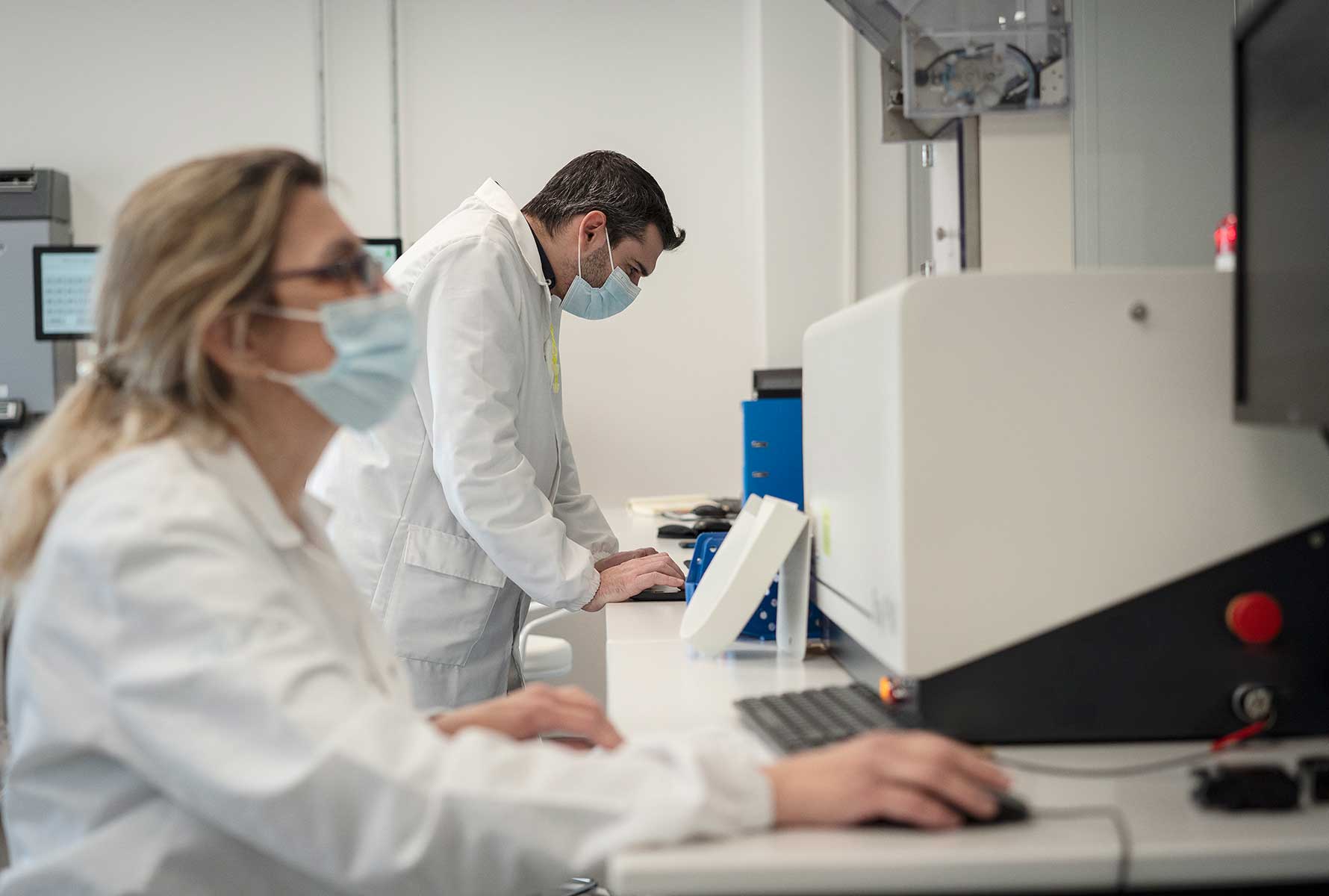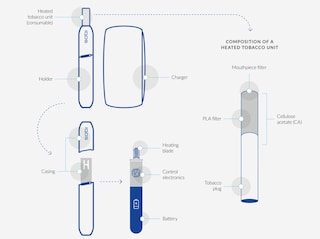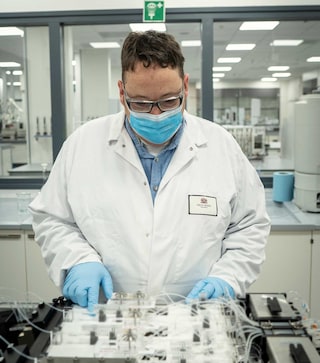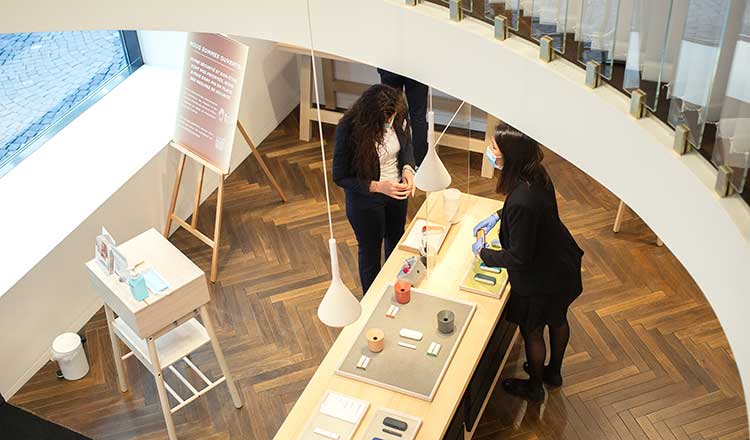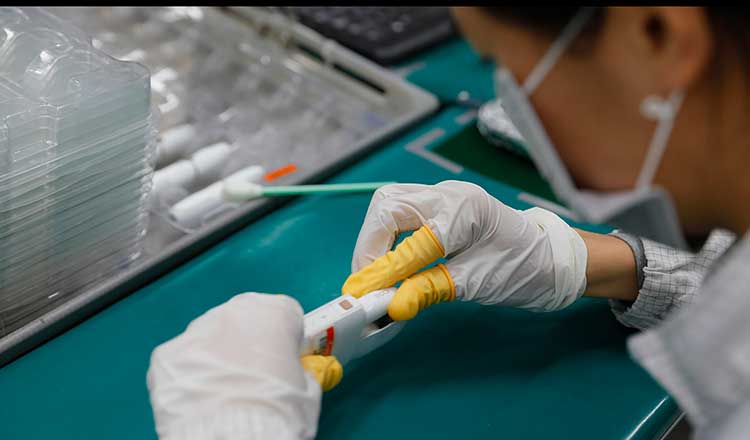Impact of COVID-19 on our activities in 2020
Smoking and COVID-19
read moreOur heat-not-burn product, IQOS
What is it, and how does it work?
Our main smoke-free product, IQOS, is a battery-powered, heat-not-burn product that heats tobacco to produce a nicotine-containing aerosol that the user inhales. There is no combustion of the tobacco. Our base model comprises three main components: A tobacco unit, a holder, and a charger. The tobacco unit is a novel product designed specifically and exclusively for use with the holder (the heating device). It contains two filter sections and specially processed tobacco designed to be heated but not burned. Tobacco leaves are ground and reconstituted into tobacco sheets, called “cast-leaf.” These sheets are then crimped and made into a tobacco plug. The user inserts the tobacco unit into the holder. Once activated, the holder heats the tobacco via an electronically controlled heating blade. Each tobacco unit provides a maximum of 14 puffs or around six minutes of consumption, whichever comes first. The holder contains a small battery, which can be recharged by inserting it into the charger; the charger, in turn, can be recharged using a household power socket. We continue to enhance our IQOS product portfolio, driven by consumer insights and supported by scientific substantiation, and currently sell a variety of models in each market.
In this chapter
- Smoking and COVID-19
- Our heat-not-burn-product, IQOS
- Our e-vapor product, IQOS VEEV
- Next steps

Product health impacts - topic overview
read moreThe different parts of an IQOS device
What scientific evidence have we gathered to date?
IQOS is the most thoroughly assessed of our smoke-free platforms. We have accumulated extensive clinical and non-clinical data to support its potential to reduce the risk of developing smoking-related diseases compared with continued cigarette smoking.
In our assessment program, we compared the chemical composition of the aerosol produced by IQOS with the smoke from a reference cigarette, using standardized and validated analytical methods to quantify the most extensive established list of harmful and potentially harmful constituents (HPHCs)—the “FDA-93”—which includes carcinogens, respiratory, and cardiovascular toxicants. We found that these HPHCs are reduced on average by 90 to 95 percent compared with the reference cigarette’s smoke. In addition, we conducted extensive chemical characterization of the IQOS aerosol. Our untargeted screening was used to identify all constituents above 100 ng/stick and resulted in the characterization of 99.8 percent of the aerosol mass. These analyses have shown that there are approximately 10 times fewer constituents in IQOS aerosol than reference cigarette smoke. As the U.S. FDA put it when it authorized a version of IQOS for sale in the US, “these chemicals are present in very low levels and potential effects are outweighed by the substantial decrease in the number and levels of HPHCs found in combusted cigarettes.”1 We also conducted indoor air chemistry and quality studies, which demonstrated that the use of IQOS does not negatively impact indoor air quality.
We conducted toxicological studies for IQOS, both in vitro and in vivo, to determine whether the reduced formation of HPHCs in the aerosol leads to reduced toxicity. Results from the in vitro studies show that the IQOS aerosol is significantly less cytotoxic and genotoxic than the smoke from cigarettes. The in vivo studies found that, compared with cigarette smoke, the reduced exposure to toxicants results in significantly reduced lung inflammation and respiratory toxicity.
1The FDA does not endorse or approve tobacco products.

In the case of our heated tobacco products, we have conducted numerous non-clinical and clinical studies. The risk reduction potential of those products is backed up by volumes of high quality research data.
In the following stage, we conducted several systems toxicology studies to assess the disease-relevant biological mechanisms affected by exposure to toxicants, using human-derived in vitro cell cultures and organotypic tissue cultures. These studies showed that, compared with the reference cigarette smoke, the IQOS aerosol has a significantly reduced impact on key mechanisms involved in the development of respiratory and cardiovascular diseases. In a systems toxicology study conducted in an animal disease model (Apoe-/–), we observed that switching to the IQOS aerosol following two months of cigarette smoke exposure reduces the development of both atherosclerosis and emphysema in a manner similar to smoking cessation. We also completed an in vivo study to assess the potential of the IQOS aerosol to reduce the risk of lung inflammation, emphysema, and lung cancer compared with cigarette smoke. The results of this study show that, in contrast to cigarette smoke, the aerosol of IQOS does not increase the incidence and number of lung tumors. The study also confirmed the significantly reduced effect of IQOS aerosol on lung inflammation and emphysema observed in the study mentioned above.1
1References: 32780830 and 32780831.
Our 14 clinical studies on IQOS have involved thousands of participants and up to 12 months of exposure
Our 14 clinical studies on IQOS have involved thousands of participants and up to 12 months of exposure. For example, we conducted four clinical studies—each involving 160 participants and an exposure period lasting five days to three months—to assess subjects’ relative exposure to toxicants when using IQOS compared with continuing to smoke cigarettes. The first two studies—incorporating a five-day exposure, in confinement—were conducted in Europe and Japan. The subsequent two studies extended over three months—a five-day confined exposure period followed by an ambulatory period of 85 days—and were conducted using a menthol version of heated tobacco units in Japan and the U.S. The ambulatory study period was intended to assess whether reductions in exposure observed in a confined setting were sustained under “real world” conditions, where factors such as environment, diet, or passive smoking could influence exposure to HPHCs. All four studies showed a significant reduction (ranging from 47 to 96 percent relative to continued cigarette smoking) in the 15 biomarkers of exposure in adult smokers who switched to IQOS. Complete switching to IQOS achieved a 95 percent reduction in exposure from smoking abstinence.
We also conducted an exposure-response study to measure clinical risk markers when adult smokers switch to IQOS for six months. The results of this study show that six months after switching to IQOS all eight co-primary biomarkers of potential harm displayed favorable changes (i.e., changes in the same direction as cessation) and that for five of the eight markers the favorable changes were statistically significant compared with continued smoking. We completed a six-month extension of the six-month exposure response study to understand what the same markers look like 12 months after switching. The study showed that in smokers who switched to IQOS the favorable changes observed at six months were maintained.
What are the external findings to date?
Our scientific results are supported by a growing body of independent research. Several government agencies have already reviewed the available evidence or conducted research of their own. In addition to studies on aerosol chemistry and toxicology, the first independent clinical and post-market studies have started to emerge. In general, these studies confirm PMI’s results, although some have contradictory interpretations of the data (e.g., using fresh air as the comparator instead of cigarette smoke), methodological differences (e.g., enrolled populations, studies that do not follow OECD guidelines), or overstated conclusions.
The list of independent studies (over 160 in total) published around PMI’s smoke-free products and/or our methods and results, as of April 29, 2021, is available on PMIscience. In 2019, a version of our heat-not-burn product IQOS became the first innovative electronic alternative to cigarettes to be authorized by the FDA for sale in the U.S. (read the decision summary here). On July 7, 2020, the FDA went one step further, allowing IQOS to be marketed as a modified risk tobacco product with the following “reduced exposure” information:
- The IQOS system heats tobacco but does not burn it.
- This significantly reduces the production of harmful and potentially harmful chemicals.
- Scientific studies have shown that switching completely from conventional cigarettes to the IQOS system significantly reduces your body’s exposure to harmful or potentially harmful chemicals.
This decision followed a multi-year review of the scientific evidence PMI submitted to the FDA in December 2016. The agency found that the use of reduced-exposure claims would be “appropriate to promote the public health and is expected to benefit the health of the population as a whole.” The FDA also concluded that the totality of the evidence presented suggests that a measurable and substantial reduction in morbidity or mortality among individual tobacco users is reasonably likely to be established in subsequent studies. The order letter, as well as the decision summary, are available on the FDA’s website.
On December 7, 2020, the FDA authorized for sale in the U.S. the IQOS 3 device, which contains a number of technological advances compared with a previously authorized version of the IQOS device, including longer battery life and a quicker recharge between uses. In its decision, the FDA noted that international survey data reviewed by the agency found no evidence of increased uptake of IQOS by youth or young adults, while use patterns available for a previously authorized version of IQOS within the U.S. have not raised new concerns regarding product use in youth and young adults.
Our e-vapor product, IQOS VEEV
Our second smoke-free product, IQOS VEEV, is an e-vapor product (or e-cigarette). The battery-powered device uses a liquid solution containing nicotine and flavoring to produce an inhalable vapor. The product is composed of a device and disposable cartridge. The device houses the battery and the puff sensor, while the cartridge holds the heating element and the e-liquid.
IQOS VEEV represents a new heating technology within the e-vapor product category. Until recently, most e-vapor products used a coil-and-wick system to heat a nicotine-containing solution. The wick draws the liquid onto a coil heating element to create an aerosol. In these systems, the temperature of the heater can vary significantly depending, for example, on the amount of liquid in the system, or how strongly the user puffs on the e-cigarette. Several studies have shown that puffing on an e-cigarette when the liquid level is low results in “dry puffs,” which can significantly increase exposure to certain toxicants—especially formaldehyde.
In IQOS VEEV, the wick is eliminated, and the coil is replaced by a metal mesh. When the liquid is introduced to the heater, the increased surface area provided by the mesh design helps heat the liquid in a more consistent way compared with current-generation coil-and-wick systems. The software ensures that the heater’s temperature is stable and does not vary based on puff strength or from puff to puff. The low-liquid detection system cuts off power to the mesh heater once the liquid has dropped below a certain level, eliminating dry puffs.
Unlike typical e-vapor product cartridges, IQOS VEEV cartridges are manufactured, assembled, pre-filled, and pre-sealed in a fully automated process to ensure product consistency. This occurs within our European production facilities. We launched the product in 2020 in New Zealand and the Czech Republic and are compiling consumer insights before proceeding with an international rollout planned in 2021. Moreover, IQOS VEEV is the first of our smoke-free products to be trialed in New Zealand with technology to prevent underage use, whereby the device can only be unlocked by registered, age-verified users.
Performance highlights
-
99%
of our R&D expenditure dedicated to smoke-free products
-
934
R&D positions, including scientists, engineers, technicians, and support staff (FTEs)
-
1,300
Patents granted to date in IP5 jurisdictions relating to smoke-free products
Next steps
We continue to invest in research to develop and scientifically substantiate a portfolio of ever-better, affordable, and acceptable smoke-free products for existing adult smokers—in both OECD and non-OECD countries. As of year-end 2020, our R&D work, and its associated innovations, has resulted in 1,300 patents granted for smoke-free technologies by the five largest intellectual property offices in the world (IP5).
To further strengthen the already robust IQOS evidence package, we are starting to complement laboratory and clinical studies with real-world evidence regarding the public health impact of the introduction of IQOS at the population level.
Finally, we will start leveraging our technical and scientific capabilities beyond the field of nicotine and reduced risk products by using our knowledge and expertise in the delivery of aerosols to humans in both wellness and medical applications such as respiratory drug delivery.

